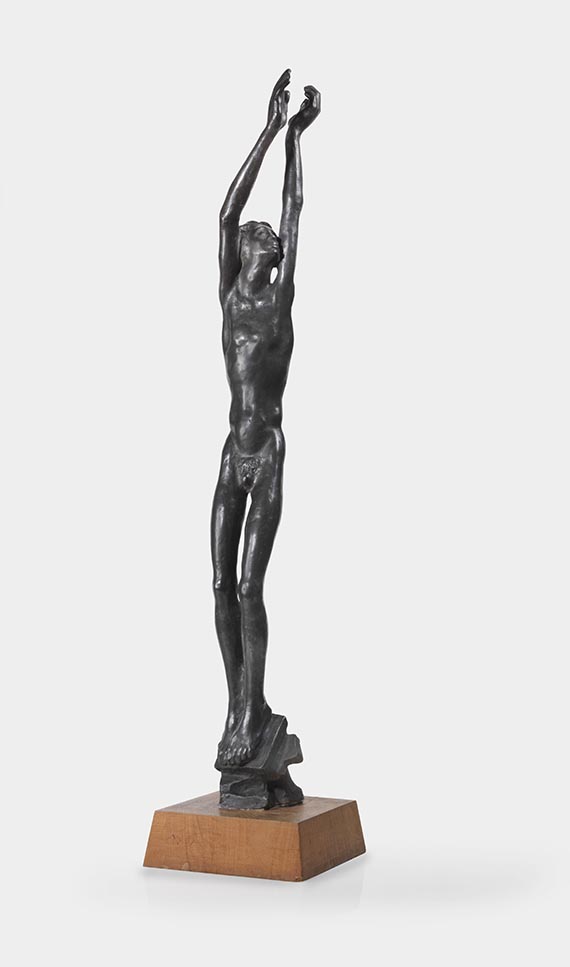Video
104
Fritz Wotruba
Genius, 1929.
Sculpture. Lead cast with black brown patina
Estimate:
€ 30,000 / $ 32,100 Sold:
€ 38,100 / $ 40,767 (incl. surcharge)
Genius. 1929.
Sculpture. Lead cast with black brown patina.
Breicha 24 (listed "Verbeib unbekannt"(whereabouts unknown). The artist's photo archive only provides proof of one cast. According to a letter from the artist to the sculpture's former owner, this is a unique cast (Wotruba Archive, Vienna). Height: 110.4 cm (43.4 in). [JS].
• This is one of the strongest creations from Wotruba's early sculptural period.
• The unusually overlong limbs deliver proof of Wotruba's fascination for Lehmbruck as well as of the occupation with the important sculptural tradition of the crucifixion.
• Unique object. Lifetime cast.
• Wotruba counts among the most important European sculptors of the 20th century.
• The Museum of Modern Art, New York, showed Wotruba's sculptures alongside works by Alberto Giacometti, Jean Dubuffet and Wilhelm de Kooning in the exhibion "New Images of Man" as early as in 1959.
PROVENANCE: Collection of Dr. Herbert and Agnes Simons, Düsseldorf/London (acquired from the artist in 1931).
Private collection London (inherited from the above in 1956).
Private collection Northern Germany (acquired in the late 1970s).
Ever since family-owned.
"When Wotruba's artistic path began, Central European Expresionism had already waned, and New Objectivity (like everything else) had nothing to offer for a young aspiring artist. If there was one model for him, it was Wilhelm Lehmbruck [..], an especially expressive artist, one who didn't belong anywhere, unmistably unique as he was and characterized by an austere fascination that is also reflected in Wotruba's work."
Otto Breicha, Fritz Wotruba. Catalogue raisonné, St. Gallen 2002, p. 8.
Sculpture. Lead cast with black brown patina.
Breicha 24 (listed "Verbeib unbekannt"(whereabouts unknown). The artist's photo archive only provides proof of one cast. According to a letter from the artist to the sculpture's former owner, this is a unique cast (Wotruba Archive, Vienna). Height: 110.4 cm (43.4 in). [JS].
• This is one of the strongest creations from Wotruba's early sculptural period.
• The unusually overlong limbs deliver proof of Wotruba's fascination for Lehmbruck as well as of the occupation with the important sculptural tradition of the crucifixion.
• Unique object. Lifetime cast.
• Wotruba counts among the most important European sculptors of the 20th century.
• The Museum of Modern Art, New York, showed Wotruba's sculptures alongside works by Alberto Giacometti, Jean Dubuffet and Wilhelm de Kooning in the exhibion "New Images of Man" as early as in 1959.
PROVENANCE: Collection of Dr. Herbert and Agnes Simons, Düsseldorf/London (acquired from the artist in 1931).
Private collection London (inherited from the above in 1956).
Private collection Northern Germany (acquired in the late 1970s).
Ever since family-owned.
"When Wotruba's artistic path began, Central European Expresionism had already waned, and New Objectivity (like everything else) had nothing to offer for a young aspiring artist. If there was one model for him, it was Wilhelm Lehmbruck [..], an especially expressive artist, one who didn't belong anywhere, unmistably unique as he was and characterized by an austere fascination that is also reflected in Wotruba's work."
Otto Breicha, Fritz Wotruba. Catalogue raisonné, St. Gallen 2002, p. 8.
In "Genius", one of the strongest creations from Wotruba's early sculptural work, the artist merges his formal enthusiasm for Wilhelm Lehmbruck's elongated forms with an examination of what is probably the most important motif in Christian iconography: the crucifixion. Not only the strongly elongated limbs of the stretched male nude refer to the long iconographic tradition of the crucified Christ, but also the slanted feet on the strongly leaning base plate. Wotruba's "Genius" thus appears to be fixed on the base, while his arms are stretched upwards, followed by his pleading, searching gaze, powerfully turned towards heaven. The crucifixion as the end of the Christian Passion becomes a symbol of the maltreated artistic genius who, freed from his earthly shackles, turns towards a dissolution of boundaries in the metaphysical.
Wotruba began his studies in the sculpture class at the School of Applied Arts in Vienna at the age of 19. Until 1928, he was a student of Anton Hanak, in whose class he met his future wife Marian Fleck. They both then attended Eugen Steinhof's class, with whom they continued the artistic discussions that had already begun in Hanak's class. In May 1929, the School of Arts and Crafts finally initiated disciplinary proceedings against the young Wotruba for intervening in a dispute between Marian and Steinhof without being asked. Wotruba was banned from the school, given leave of absence for the rest of the academic year and was eventually expelled at the end of the 1929 school year. The aspiring "genius" that Wotruba created that year, seemingly wriggling out of his shackles, is thus also a symbol of Wotruba's artistic self-image, which eludes the classic path of an authoritarian academic education. [JS]
Wotruba began his studies in the sculpture class at the School of Applied Arts in Vienna at the age of 19. Until 1928, he was a student of Anton Hanak, in whose class he met his future wife Marian Fleck. They both then attended Eugen Steinhof's class, with whom they continued the artistic discussions that had already begun in Hanak's class. In May 1929, the School of Arts and Crafts finally initiated disciplinary proceedings against the young Wotruba for intervening in a dispute between Marian and Steinhof without being asked. Wotruba was banned from the school, given leave of absence for the rest of the academic year and was eventually expelled at the end of the 1929 school year. The aspiring "genius" that Wotruba created that year, seemingly wriggling out of his shackles, is thus also a symbol of Wotruba's artistic self-image, which eludes the classic path of an authoritarian academic education. [JS]
104
Fritz Wotruba
Genius, 1929.
Sculpture. Lead cast with black brown patina
Estimate:
€ 30,000 / $ 32,100 Sold:
€ 38,100 / $ 40,767 (incl. surcharge)




 Lot 104
Lot 104 
